Comparative Analysis of Contemporary Accounting Issues in Airlines
VerifiedAdded on 2020/03/04
|17
|2548
|31
Report
AI Summary
This report offers a comparative analysis of the accounting frameworks employed by Virgin Australia Airlines and Qantas Airways, evaluating their compliance with relevant accounting standards. The study introduces the concept of prudence to address potential disparities in reporting practices. It examines the companies' annual reports, focusing on tangible and intangible assets, revenue recognition, and depreciation methods. The report also investigates the rationale behind shareholder investments, highlighting revenue and operating margin trends. Both airlines adhere to AASB and Corporations Act 2001. The analysis covers the application of prudence theory, particularly regarding asset valuation and liability recognition, and the adoption of new standards like AASB 15 and AASB 16. The report concludes with an overview of the financial data and investment considerations, providing insights into the financial performance and accounting practices of these major Australian airlines.
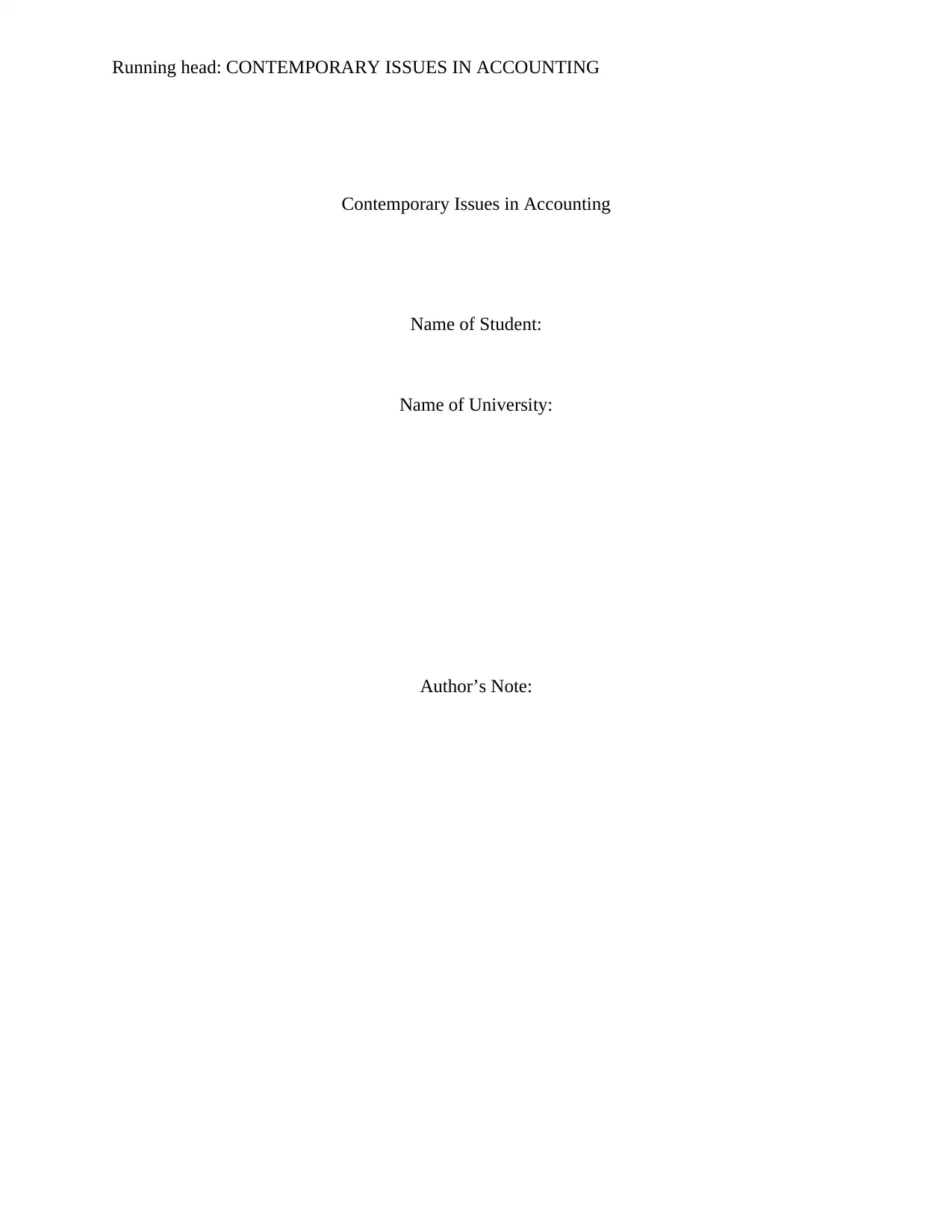
Running head: CONTEMPORARY ISSUES IN ACCOUNTING
Contemporary Issues in Accounting
Name of Student:
Name of University:
Author’s Note:
Contemporary Issues in Accounting
Name of Student:
Name of University:
Author’s Note:
Paraphrase This Document
Need a fresh take? Get an instant paraphrase of this document with our AI Paraphraser
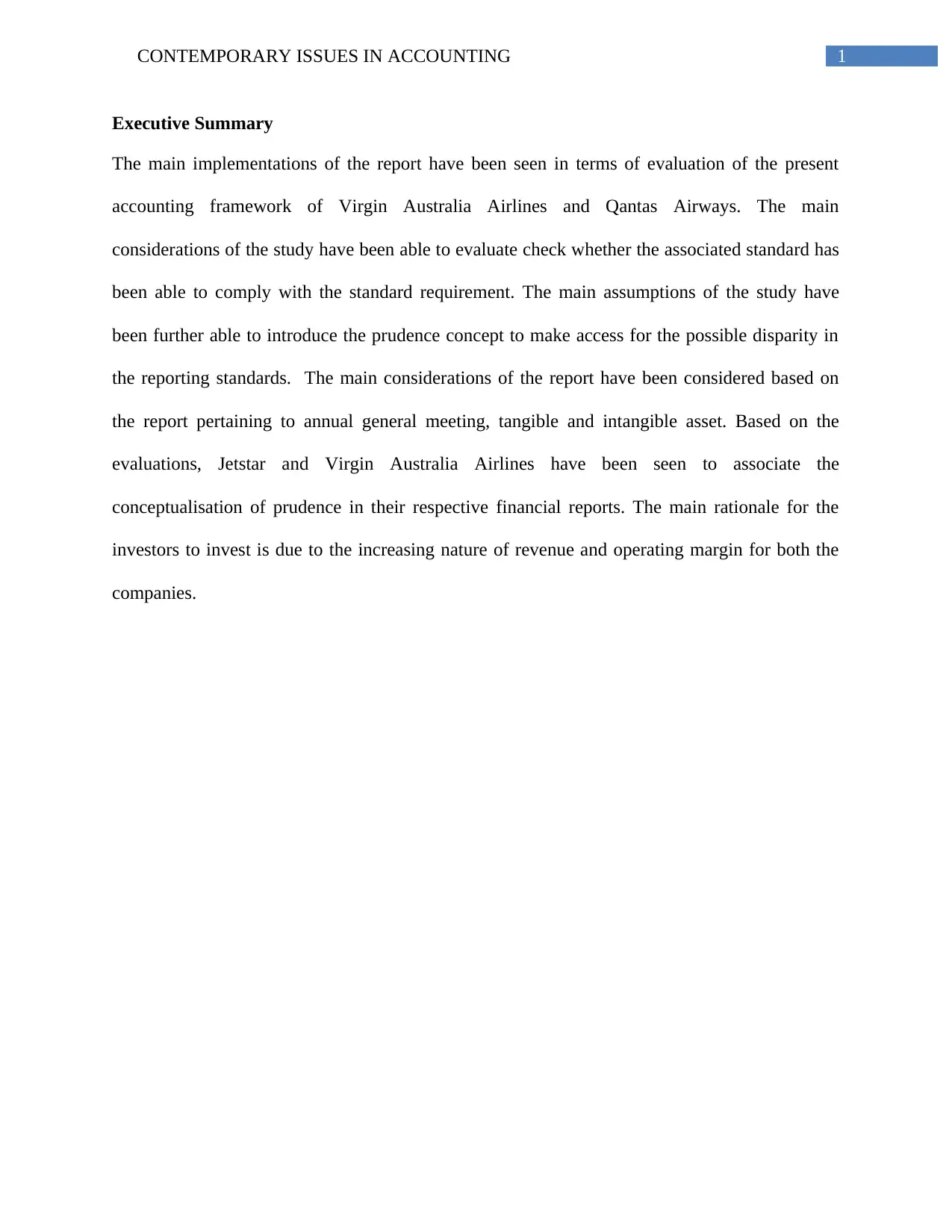
1CONTEMPORARY ISSUES IN ACCOUNTING
Executive Summary
The main implementations of the report have been seen in terms of evaluation of the present
accounting framework of Virgin Australia Airlines and Qantas Airways. The main
considerations of the study have been able to evaluate check whether the associated standard has
been able to comply with the standard requirement. The main assumptions of the study have
been further able to introduce the prudence concept to make access for the possible disparity in
the reporting standards. The main considerations of the report have been considered based on
the report pertaining to annual general meeting, tangible and intangible asset. Based on the
evaluations, Jetstar and Virgin Australia Airlines have been seen to associate the
conceptualisation of prudence in their respective financial reports. The main rationale for the
investors to invest is due to the increasing nature of revenue and operating margin for both the
companies.
Executive Summary
The main implementations of the report have been seen in terms of evaluation of the present
accounting framework of Virgin Australia Airlines and Qantas Airways. The main
considerations of the study have been able to evaluate check whether the associated standard has
been able to comply with the standard requirement. The main assumptions of the study have
been further able to introduce the prudence concept to make access for the possible disparity in
the reporting standards. The main considerations of the report have been considered based on
the report pertaining to annual general meeting, tangible and intangible asset. Based on the
evaluations, Jetstar and Virgin Australia Airlines have been seen to associate the
conceptualisation of prudence in their respective financial reports. The main rationale for the
investors to invest is due to the increasing nature of revenue and operating margin for both the
companies.
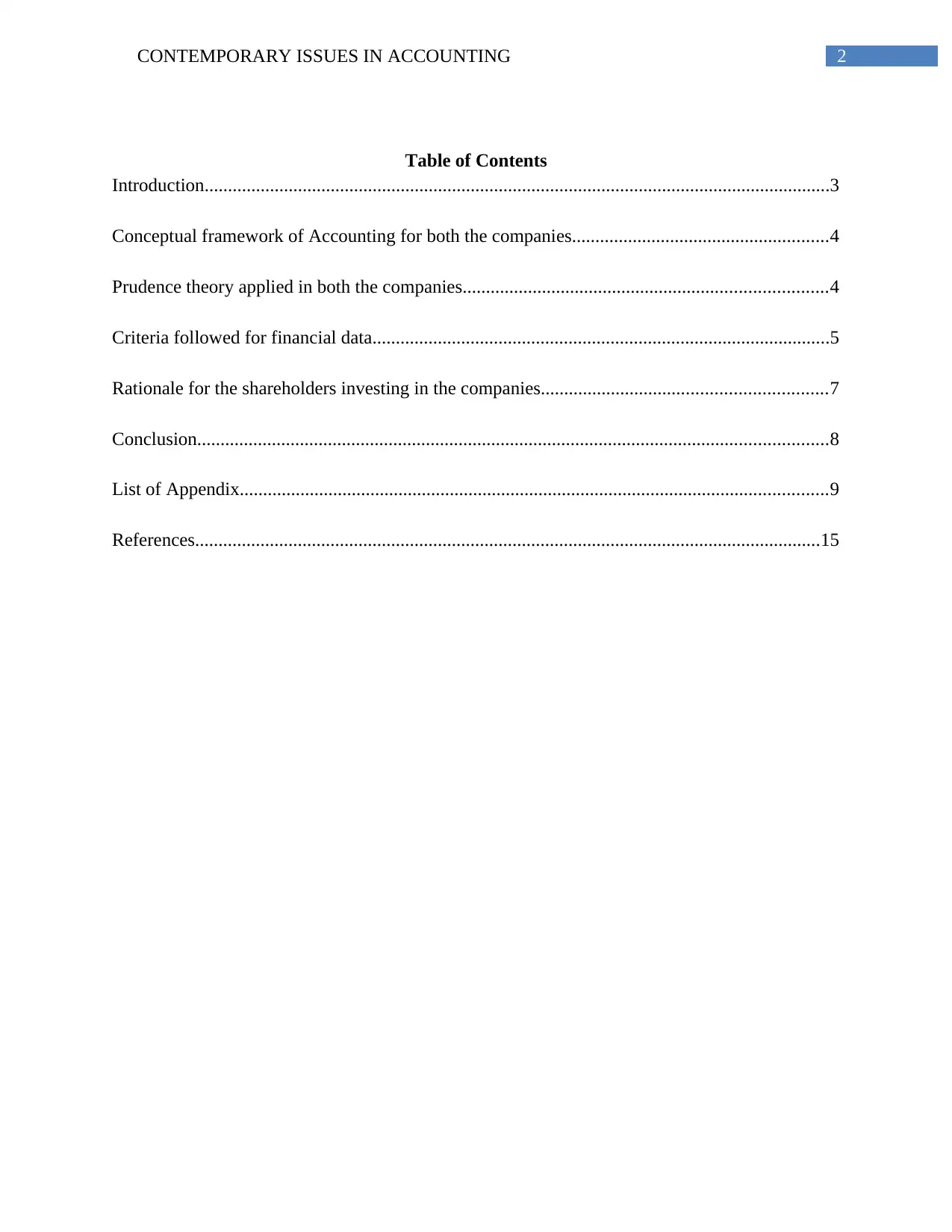
2CONTEMPORARY ISSUES IN ACCOUNTING
Table of Contents
Introduction......................................................................................................................................3
Conceptual framework of Accounting for both the companies.......................................................4
Prudence theory applied in both the companies..............................................................................4
Criteria followed for financial data..................................................................................................5
Rationale for the shareholders investing in the companies.............................................................7
Conclusion.......................................................................................................................................8
List of Appendix..............................................................................................................................9
References......................................................................................................................................15
Table of Contents
Introduction......................................................................................................................................3
Conceptual framework of Accounting for both the companies.......................................................4
Prudence theory applied in both the companies..............................................................................4
Criteria followed for financial data..................................................................................................5
Rationale for the shareholders investing in the companies.............................................................7
Conclusion.......................................................................................................................................8
List of Appendix..............................................................................................................................9
References......................................................................................................................................15
⊘ This is a preview!⊘
Do you want full access?
Subscribe today to unlock all pages.

Trusted by 1+ million students worldwide
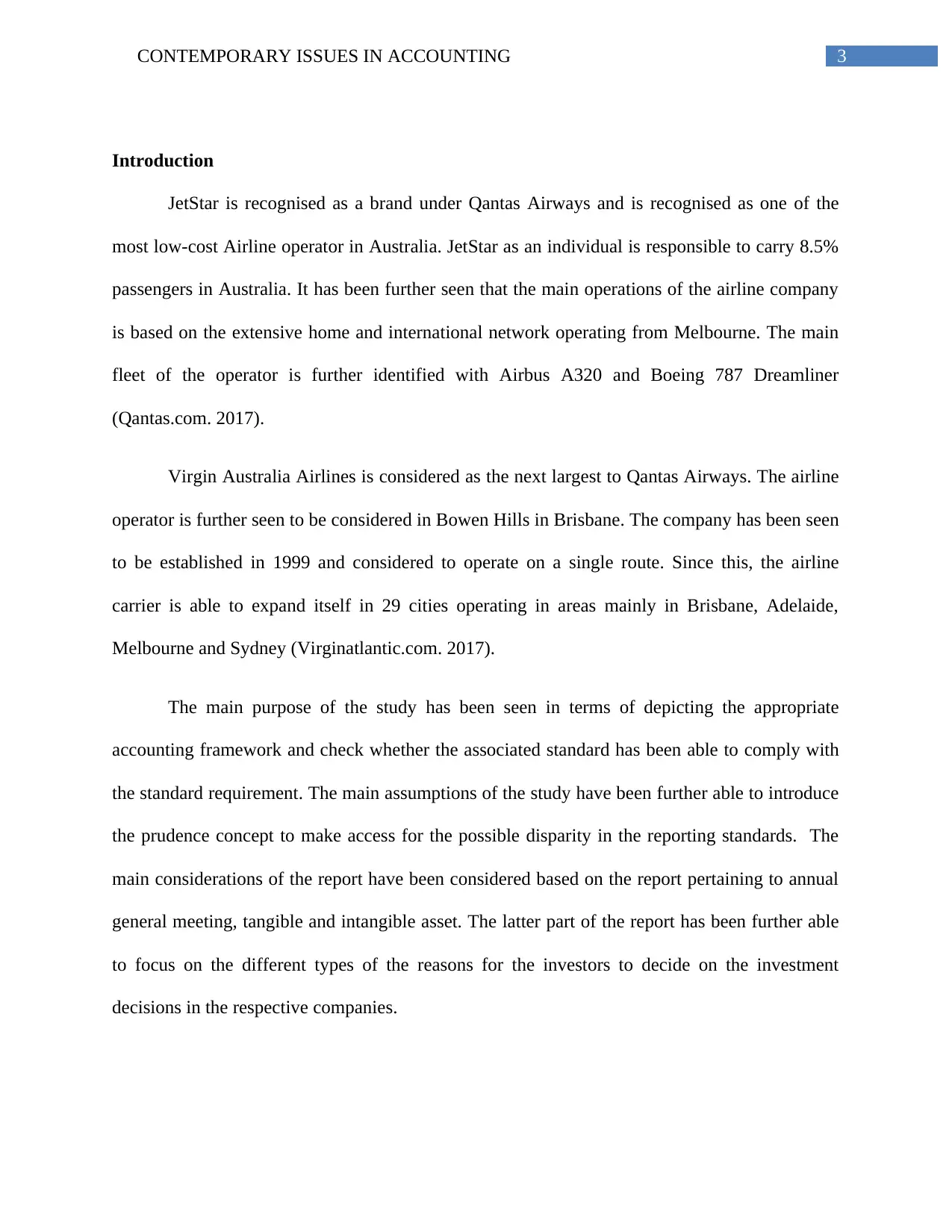
3CONTEMPORARY ISSUES IN ACCOUNTING
Introduction
JetStar is recognised as a brand under Qantas Airways and is recognised as one of the
most low-cost Airline operator in Australia. JetStar as an individual is responsible to carry 8.5%
passengers in Australia. It has been further seen that the main operations of the airline company
is based on the extensive home and international network operating from Melbourne. The main
fleet of the operator is further identified with Airbus A320 and Boeing 787 Dreamliner
(Qantas.com. 2017).
Virgin Australia Airlines is considered as the next largest to Qantas Airways. The airline
operator is further seen to be considered in Bowen Hills in Brisbane. The company has been seen
to be established in 1999 and considered to operate on a single route. Since this, the airline
carrier is able to expand itself in 29 cities operating in areas mainly in Brisbane, Adelaide,
Melbourne and Sydney (Virginatlantic.com. 2017).
The main purpose of the study has been seen in terms of depicting the appropriate
accounting framework and check whether the associated standard has been able to comply with
the standard requirement. The main assumptions of the study have been further able to introduce
the prudence concept to make access for the possible disparity in the reporting standards. The
main considerations of the report have been considered based on the report pertaining to annual
general meeting, tangible and intangible asset. The latter part of the report has been further able
to focus on the different types of the reasons for the investors to decide on the investment
decisions in the respective companies.
Introduction
JetStar is recognised as a brand under Qantas Airways and is recognised as one of the
most low-cost Airline operator in Australia. JetStar as an individual is responsible to carry 8.5%
passengers in Australia. It has been further seen that the main operations of the airline company
is based on the extensive home and international network operating from Melbourne. The main
fleet of the operator is further identified with Airbus A320 and Boeing 787 Dreamliner
(Qantas.com. 2017).
Virgin Australia Airlines is considered as the next largest to Qantas Airways. The airline
operator is further seen to be considered in Bowen Hills in Brisbane. The company has been seen
to be established in 1999 and considered to operate on a single route. Since this, the airline
carrier is able to expand itself in 29 cities operating in areas mainly in Brisbane, Adelaide,
Melbourne and Sydney (Virginatlantic.com. 2017).
The main purpose of the study has been seen in terms of depicting the appropriate
accounting framework and check whether the associated standard has been able to comply with
the standard requirement. The main assumptions of the study have been further able to introduce
the prudence concept to make access for the possible disparity in the reporting standards. The
main considerations of the report have been considered based on the report pertaining to annual
general meeting, tangible and intangible asset. The latter part of the report has been further able
to focus on the different types of the reasons for the investors to decide on the investment
decisions in the respective companies.
Paraphrase This Document
Need a fresh take? Get an instant paraphrase of this document with our AI Paraphraser
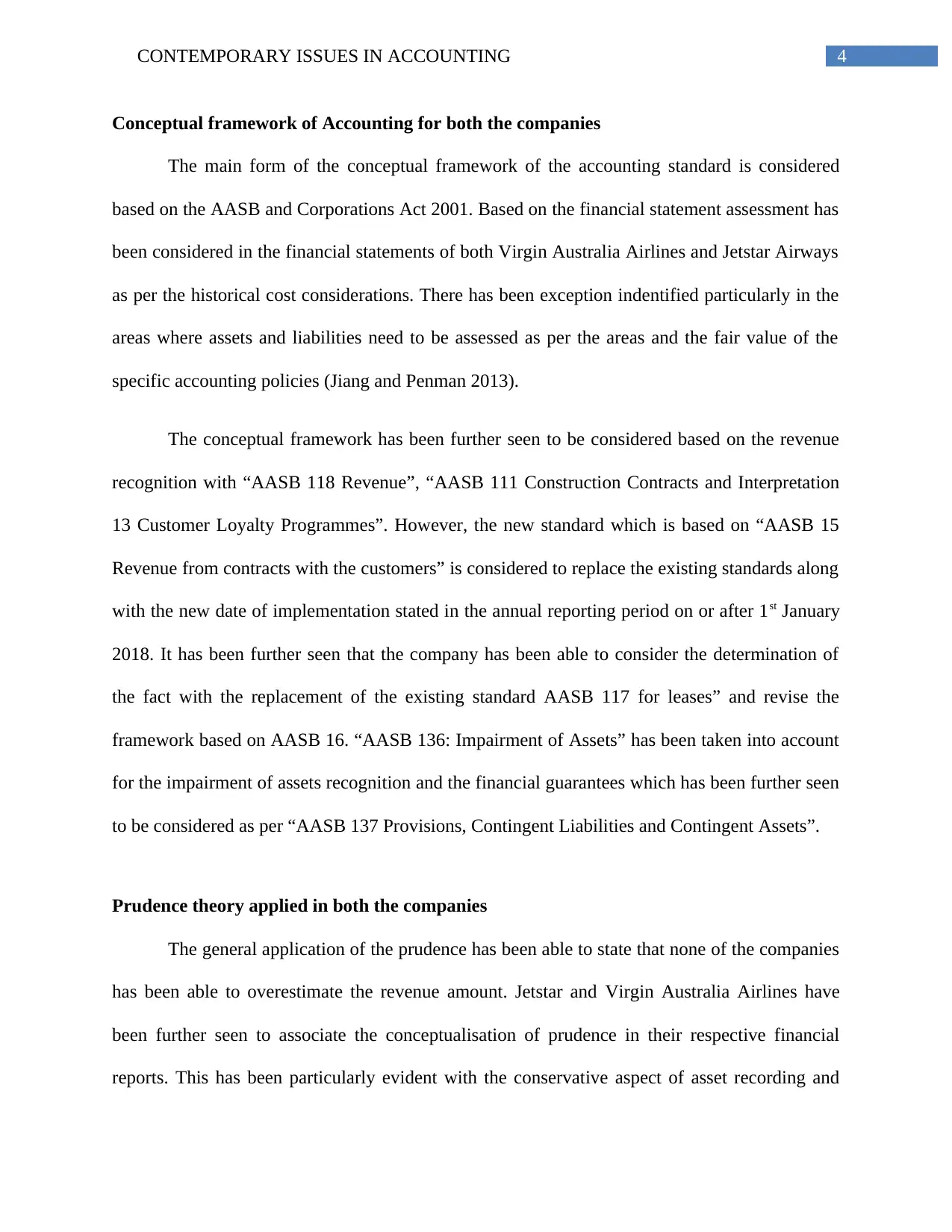
4CONTEMPORARY ISSUES IN ACCOUNTING
Conceptual framework of Accounting for both the companies
The main form of the conceptual framework of the accounting standard is considered
based on the AASB and Corporations Act 2001. Based on the financial statement assessment has
been considered in the financial statements of both Virgin Australia Airlines and Jetstar Airways
as per the historical cost considerations. There has been exception indentified particularly in the
areas where assets and liabilities need to be assessed as per the areas and the fair value of the
specific accounting policies (Jiang and Penman 2013).
The conceptual framework has been further seen to be considered based on the revenue
recognition with “AASB 118 Revenue”, “AASB 111 Construction Contracts and Interpretation
13 Customer Loyalty Programmes”. However, the new standard which is based on “AASB 15
Revenue from contracts with the customers” is considered to replace the existing standards along
with the new date of implementation stated in the annual reporting period on or after 1st January
2018. It has been further seen that the company has been able to consider the determination of
the fact with the replacement of the existing standard AASB 117 for leases” and revise the
framework based on AASB 16. “AASB 136: Impairment of Assets” has been taken into account
for the impairment of assets recognition and the financial guarantees which has been further seen
to be considered as per “AASB 137 Provisions, Contingent Liabilities and Contingent Assets”.
Prudence theory applied in both the companies
The general application of the prudence has been able to state that none of the companies
has been able to overestimate the revenue amount. Jetstar and Virgin Australia Airlines have
been further seen to associate the conceptualisation of prudence in their respective financial
reports. This has been particularly evident with the conservative aspect of asset recording and
Conceptual framework of Accounting for both the companies
The main form of the conceptual framework of the accounting standard is considered
based on the AASB and Corporations Act 2001. Based on the financial statement assessment has
been considered in the financial statements of both Virgin Australia Airlines and Jetstar Airways
as per the historical cost considerations. There has been exception indentified particularly in the
areas where assets and liabilities need to be assessed as per the areas and the fair value of the
specific accounting policies (Jiang and Penman 2013).
The conceptual framework has been further seen to be considered based on the revenue
recognition with “AASB 118 Revenue”, “AASB 111 Construction Contracts and Interpretation
13 Customer Loyalty Programmes”. However, the new standard which is based on “AASB 15
Revenue from contracts with the customers” is considered to replace the existing standards along
with the new date of implementation stated in the annual reporting period on or after 1st January
2018. It has been further seen that the company has been able to consider the determination of
the fact with the replacement of the existing standard AASB 117 for leases” and revise the
framework based on AASB 16. “AASB 136: Impairment of Assets” has been taken into account
for the impairment of assets recognition and the financial guarantees which has been further seen
to be considered as per “AASB 137 Provisions, Contingent Liabilities and Contingent Assets”.
Prudence theory applied in both the companies
The general application of the prudence has been able to state that none of the companies
has been able to overestimate the revenue amount. Jetstar and Virgin Australia Airlines have
been further seen to associate the conceptualisation of prudence in their respective financial
reports. This has been particularly evident with the conservative aspect of asset recording and
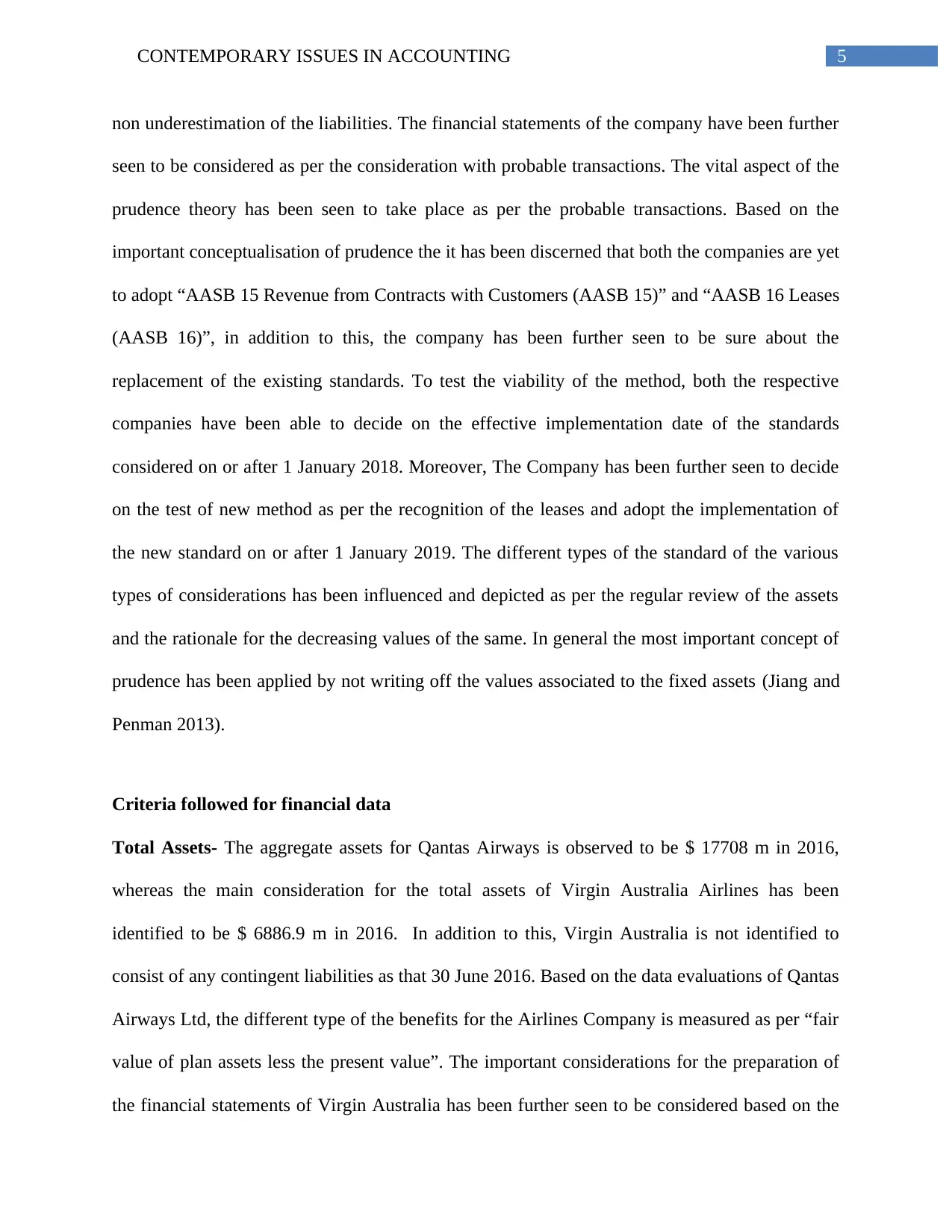
5CONTEMPORARY ISSUES IN ACCOUNTING
non underestimation of the liabilities. The financial statements of the company have been further
seen to be considered as per the consideration with probable transactions. The vital aspect of the
prudence theory has been seen to take place as per the probable transactions. Based on the
important conceptualisation of prudence the it has been discerned that both the companies are yet
to adopt “AASB 15 Revenue from Contracts with Customers (AASB 15)” and “AASB 16 Leases
(AASB 16)”, in addition to this, the company has been further seen to be sure about the
replacement of the existing standards. To test the viability of the method, both the respective
companies have been able to decide on the effective implementation date of the standards
considered on or after 1 January 2018. Moreover, The Company has been further seen to decide
on the test of new method as per the recognition of the leases and adopt the implementation of
the new standard on or after 1 January 2019. The different types of the standard of the various
types of considerations has been influenced and depicted as per the regular review of the assets
and the rationale for the decreasing values of the same. In general the most important concept of
prudence has been applied by not writing off the values associated to the fixed assets (Jiang and
Penman 2013).
Criteria followed for financial data
Total Assets- The aggregate assets for Qantas Airways is observed to be $ 17708 m in 2016,
whereas the main consideration for the total assets of Virgin Australia Airlines has been
identified to be $ 6886.9 m in 2016. In addition to this, Virgin Australia is not identified to
consist of any contingent liabilities as that 30 June 2016. Based on the data evaluations of Qantas
Airways Ltd, the different type of the benefits for the Airlines Company is measured as per “fair
value of plan assets less the present value”. The important considerations for the preparation of
the financial statements of Virgin Australia has been further seen to be considered based on the
non underestimation of the liabilities. The financial statements of the company have been further
seen to be considered as per the consideration with probable transactions. The vital aspect of the
prudence theory has been seen to take place as per the probable transactions. Based on the
important conceptualisation of prudence the it has been discerned that both the companies are yet
to adopt “AASB 15 Revenue from Contracts with Customers (AASB 15)” and “AASB 16 Leases
(AASB 16)”, in addition to this, the company has been further seen to be sure about the
replacement of the existing standards. To test the viability of the method, both the respective
companies have been able to decide on the effective implementation date of the standards
considered on or after 1 January 2018. Moreover, The Company has been further seen to decide
on the test of new method as per the recognition of the leases and adopt the implementation of
the new standard on or after 1 January 2019. The different types of the standard of the various
types of considerations has been influenced and depicted as per the regular review of the assets
and the rationale for the decreasing values of the same. In general the most important concept of
prudence has been applied by not writing off the values associated to the fixed assets (Jiang and
Penman 2013).
Criteria followed for financial data
Total Assets- The aggregate assets for Qantas Airways is observed to be $ 17708 m in 2016,
whereas the main consideration for the total assets of Virgin Australia Airlines has been
identified to be $ 6886.9 m in 2016. In addition to this, Virgin Australia is not identified to
consist of any contingent liabilities as that 30 June 2016. Based on the data evaluations of Qantas
Airways Ltd, the different type of the benefits for the Airlines Company is measured as per “fair
value of plan assets less the present value”. The important considerations for the preparation of
the financial statements of Virgin Australia has been further seen to be considered based on the
⊘ This is a preview!⊘
Do you want full access?
Subscribe today to unlock all pages.

Trusted by 1+ million students worldwide
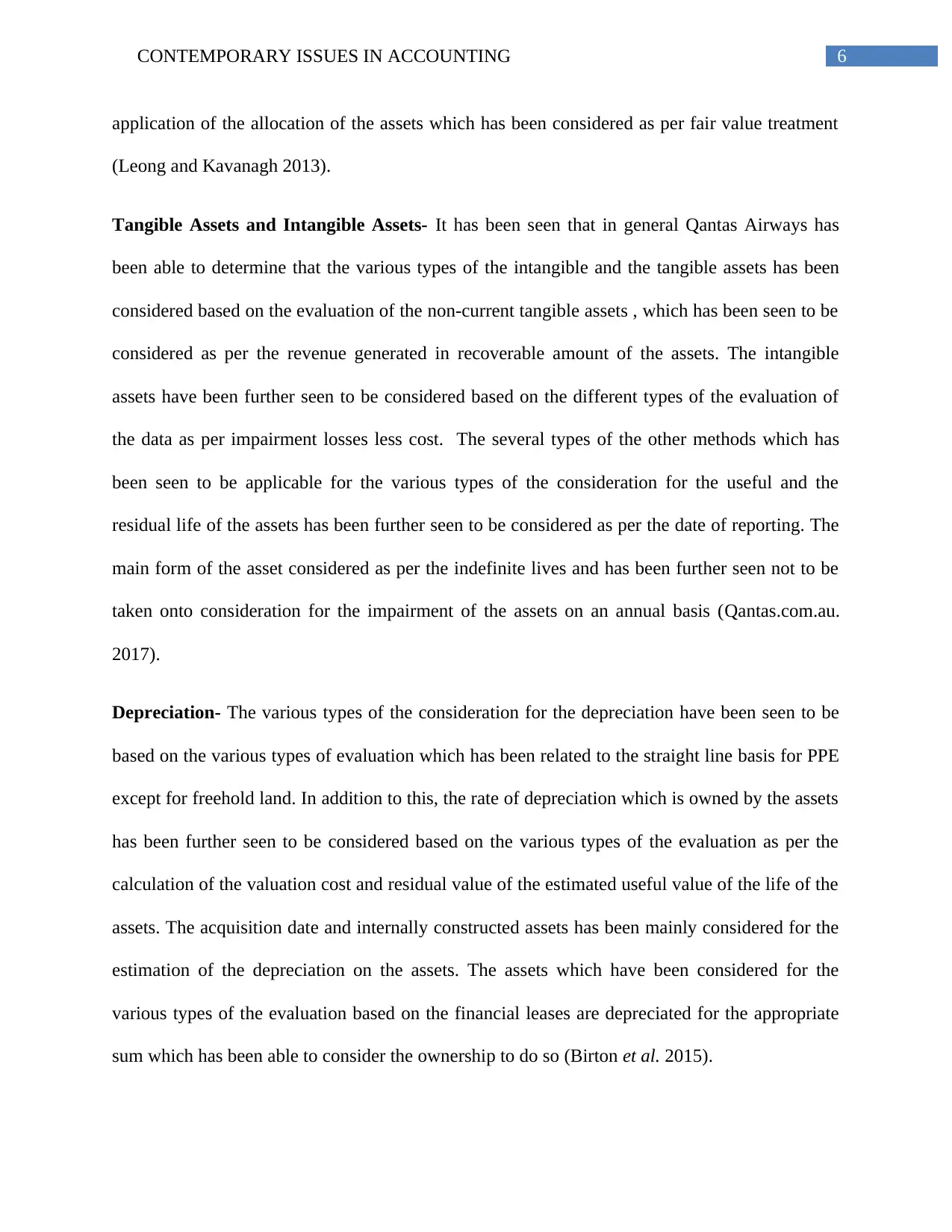
6CONTEMPORARY ISSUES IN ACCOUNTING
application of the allocation of the assets which has been considered as per fair value treatment
(Leong and Kavanagh 2013).
Tangible Assets and Intangible Assets- It has been seen that in general Qantas Airways has
been able to determine that the various types of the intangible and the tangible assets has been
considered based on the evaluation of the non-current tangible assets , which has been seen to be
considered as per the revenue generated in recoverable amount of the assets. The intangible
assets have been further seen to be considered based on the different types of the evaluation of
the data as per impairment losses less cost. The several types of the other methods which has
been seen to be applicable for the various types of the consideration for the useful and the
residual life of the assets has been further seen to be considered as per the date of reporting. The
main form of the asset considered as per the indefinite lives and has been further seen not to be
taken onto consideration for the impairment of the assets on an annual basis (Qantas.com.au.
2017).
Depreciation- The various types of the consideration for the depreciation have been seen to be
based on the various types of evaluation which has been related to the straight line basis for PPE
except for freehold land. In addition to this, the rate of depreciation which is owned by the assets
has been further seen to be considered based on the various types of the evaluation as per the
calculation of the valuation cost and residual value of the estimated useful value of the life of the
assets. The acquisition date and internally constructed assets has been mainly considered for the
estimation of the depreciation on the assets. The assets which have been considered for the
various types of the evaluation based on the financial leases are depreciated for the appropriate
sum which has been able to consider the ownership to do so (Birton et al. 2015).
application of the allocation of the assets which has been considered as per fair value treatment
(Leong and Kavanagh 2013).
Tangible Assets and Intangible Assets- It has been seen that in general Qantas Airways has
been able to determine that the various types of the intangible and the tangible assets has been
considered based on the evaluation of the non-current tangible assets , which has been seen to be
considered as per the revenue generated in recoverable amount of the assets. The intangible
assets have been further seen to be considered based on the different types of the evaluation of
the data as per impairment losses less cost. The several types of the other methods which has
been seen to be applicable for the various types of the consideration for the useful and the
residual life of the assets has been further seen to be considered as per the date of reporting. The
main form of the asset considered as per the indefinite lives and has been further seen not to be
taken onto consideration for the impairment of the assets on an annual basis (Qantas.com.au.
2017).
Depreciation- The various types of the consideration for the depreciation have been seen to be
based on the various types of evaluation which has been related to the straight line basis for PPE
except for freehold land. In addition to this, the rate of depreciation which is owned by the assets
has been further seen to be considered based on the various types of the evaluation as per the
calculation of the valuation cost and residual value of the estimated useful value of the life of the
assets. The acquisition date and internally constructed assets has been mainly considered for the
estimation of the depreciation on the assets. The assets which have been considered for the
various types of the evaluation based on the financial leases are depreciated for the appropriate
sum which has been able to consider the ownership to do so (Birton et al. 2015).
Paraphrase This Document
Need a fresh take? Get an instant paraphrase of this document with our AI Paraphraser
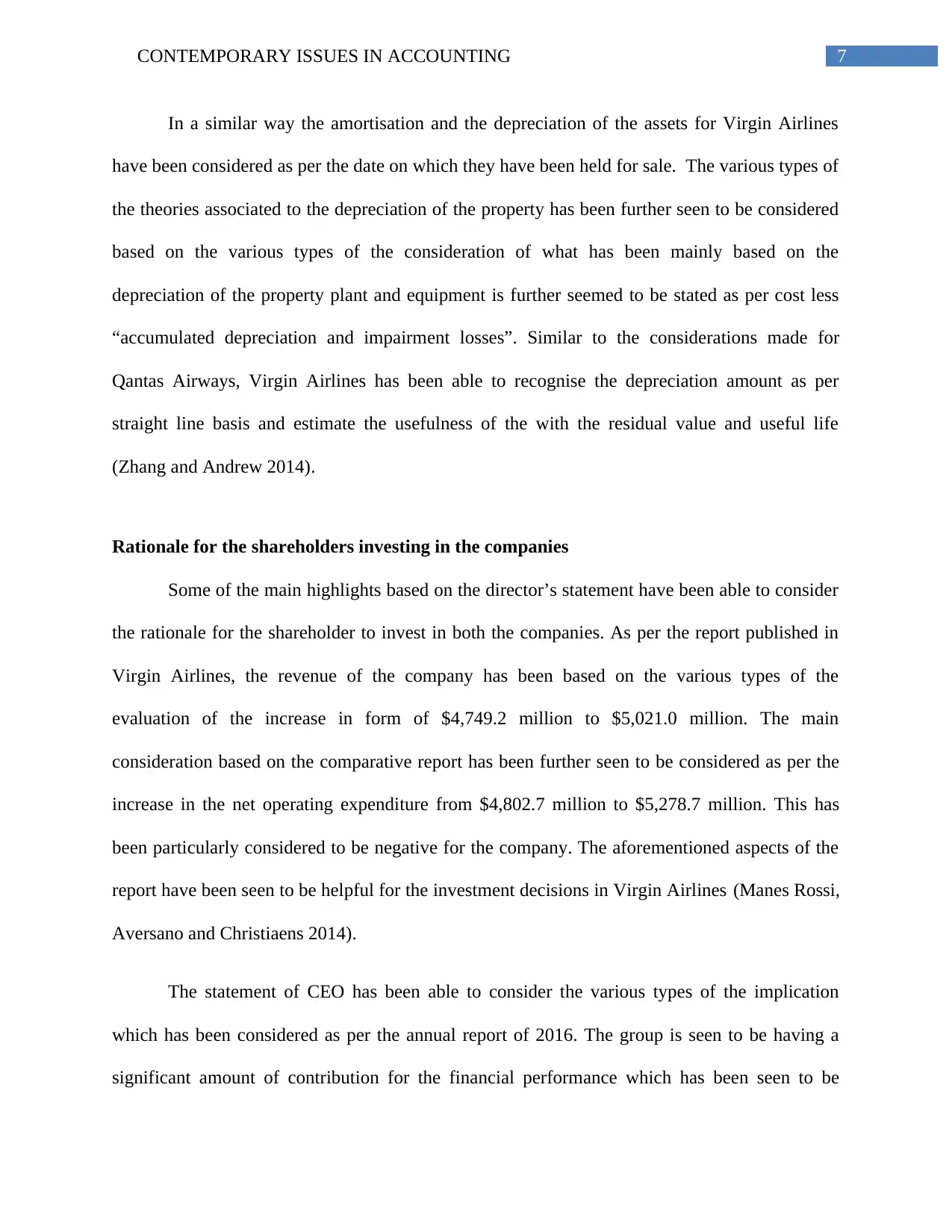
7CONTEMPORARY ISSUES IN ACCOUNTING
In a similar way the amortisation and the depreciation of the assets for Virgin Airlines
have been considered as per the date on which they have been held for sale. The various types of
the theories associated to the depreciation of the property has been further seen to be considered
based on the various types of the consideration of what has been mainly based on the
depreciation of the property plant and equipment is further seemed to be stated as per cost less
“accumulated depreciation and impairment losses”. Similar to the considerations made for
Qantas Airways, Virgin Airlines has been able to recognise the depreciation amount as per
straight line basis and estimate the usefulness of the with the residual value and useful life
(Zhang and Andrew 2014).
Rationale for the shareholders investing in the companies
Some of the main highlights based on the director’s statement have been able to consider
the rationale for the shareholder to invest in both the companies. As per the report published in
Virgin Airlines, the revenue of the company has been based on the various types of the
evaluation of the increase in form of $4,749.2 million to $5,021.0 million. The main
consideration based on the comparative report has been further seen to be considered as per the
increase in the net operating expenditure from $4,802.7 million to $5,278.7 million. This has
been particularly considered to be negative for the company. The aforementioned aspects of the
report have been seen to be helpful for the investment decisions in Virgin Airlines (Manes Rossi,
Aversano and Christiaens 2014).
The statement of CEO has been able to consider the various types of the implication
which has been considered as per the annual report of 2016. The group is seen to be having a
significant amount of contribution for the financial performance which has been seen to be
In a similar way the amortisation and the depreciation of the assets for Virgin Airlines
have been considered as per the date on which they have been held for sale. The various types of
the theories associated to the depreciation of the property has been further seen to be considered
based on the various types of the consideration of what has been mainly based on the
depreciation of the property plant and equipment is further seemed to be stated as per cost less
“accumulated depreciation and impairment losses”. Similar to the considerations made for
Qantas Airways, Virgin Airlines has been able to recognise the depreciation amount as per
straight line basis and estimate the usefulness of the with the residual value and useful life
(Zhang and Andrew 2014).
Rationale for the shareholders investing in the companies
Some of the main highlights based on the director’s statement have been able to consider
the rationale for the shareholder to invest in both the companies. As per the report published in
Virgin Airlines, the revenue of the company has been based on the various types of the
evaluation of the increase in form of $4,749.2 million to $5,021.0 million. The main
consideration based on the comparative report has been further seen to be considered as per the
increase in the net operating expenditure from $4,802.7 million to $5,278.7 million. This has
been particularly considered to be negative for the company. The aforementioned aspects of the
report have been seen to be helpful for the investment decisions in Virgin Airlines (Manes Rossi,
Aversano and Christiaens 2014).
The statement of CEO has been able to consider the various types of the implication
which has been considered as per the annual report of 2016. The group is seen to be having a
significant amount of contribution for the financial performance which has been seen to be
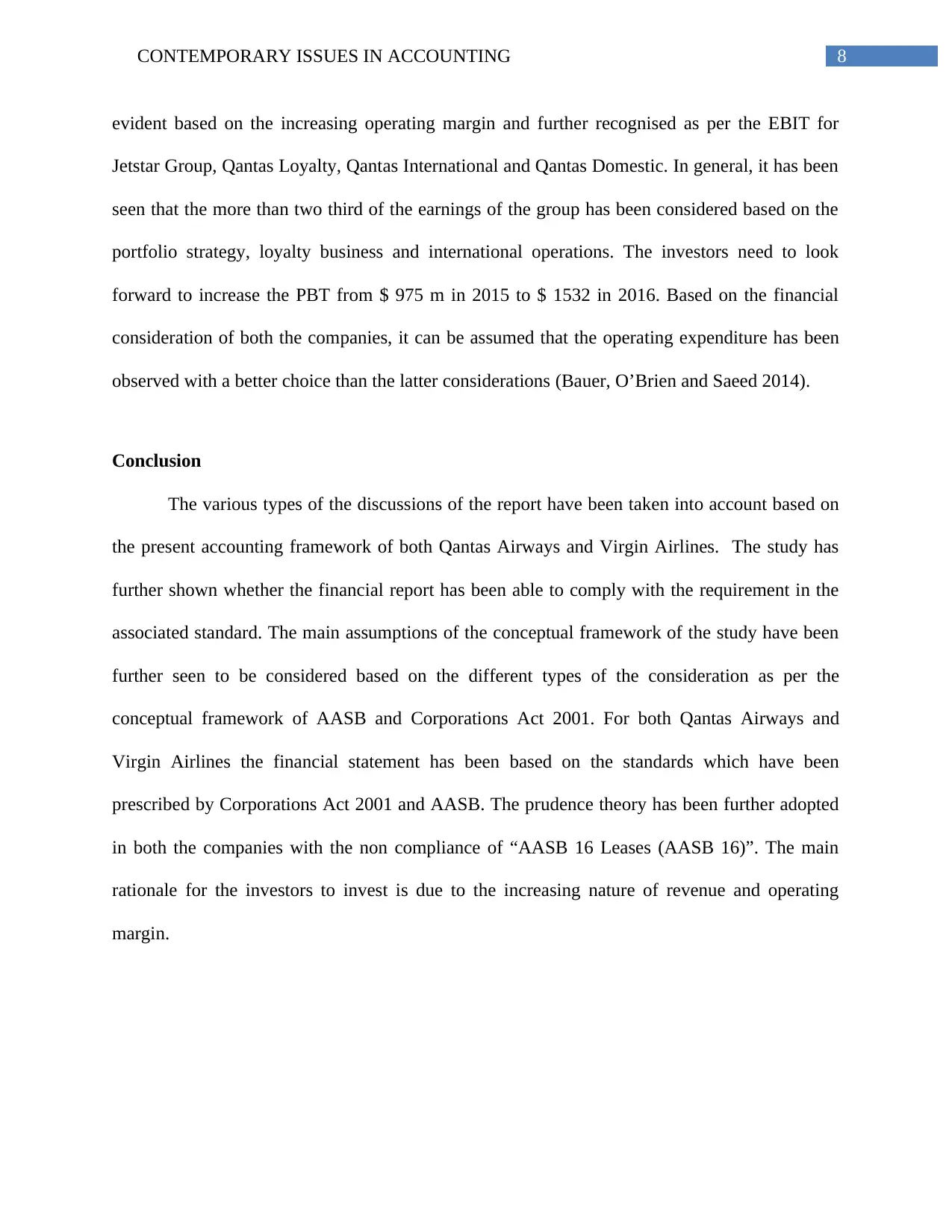
8CONTEMPORARY ISSUES IN ACCOUNTING
evident based on the increasing operating margin and further recognised as per the EBIT for
Jetstar Group, Qantas Loyalty, Qantas International and Qantas Domestic. In general, it has been
seen that the more than two third of the earnings of the group has been considered based on the
portfolio strategy, loyalty business and international operations. The investors need to look
forward to increase the PBT from $ 975 m in 2015 to $ 1532 in 2016. Based on the financial
consideration of both the companies, it can be assumed that the operating expenditure has been
observed with a better choice than the latter considerations (Bauer, O’Brien and Saeed 2014).
Conclusion
The various types of the discussions of the report have been taken into account based on
the present accounting framework of both Qantas Airways and Virgin Airlines. The study has
further shown whether the financial report has been able to comply with the requirement in the
associated standard. The main assumptions of the conceptual framework of the study have been
further seen to be considered based on the different types of the consideration as per the
conceptual framework of AASB and Corporations Act 2001. For both Qantas Airways and
Virgin Airlines the financial statement has been based on the standards which have been
prescribed by Corporations Act 2001 and AASB. The prudence theory has been further adopted
in both the companies with the non compliance of “AASB 16 Leases (AASB 16)”. The main
rationale for the investors to invest is due to the increasing nature of revenue and operating
margin.
evident based on the increasing operating margin and further recognised as per the EBIT for
Jetstar Group, Qantas Loyalty, Qantas International and Qantas Domestic. In general, it has been
seen that the more than two third of the earnings of the group has been considered based on the
portfolio strategy, loyalty business and international operations. The investors need to look
forward to increase the PBT from $ 975 m in 2015 to $ 1532 in 2016. Based on the financial
consideration of both the companies, it can be assumed that the operating expenditure has been
observed with a better choice than the latter considerations (Bauer, O’Brien and Saeed 2014).
Conclusion
The various types of the discussions of the report have been taken into account based on
the present accounting framework of both Qantas Airways and Virgin Airlines. The study has
further shown whether the financial report has been able to comply with the requirement in the
associated standard. The main assumptions of the conceptual framework of the study have been
further seen to be considered based on the different types of the consideration as per the
conceptual framework of AASB and Corporations Act 2001. For both Qantas Airways and
Virgin Airlines the financial statement has been based on the standards which have been
prescribed by Corporations Act 2001 and AASB. The prudence theory has been further adopted
in both the companies with the non compliance of “AASB 16 Leases (AASB 16)”. The main
rationale for the investors to invest is due to the increasing nature of revenue and operating
margin.
⊘ This is a preview!⊘
Do you want full access?
Subscribe today to unlock all pages.

Trusted by 1+ million students worldwide
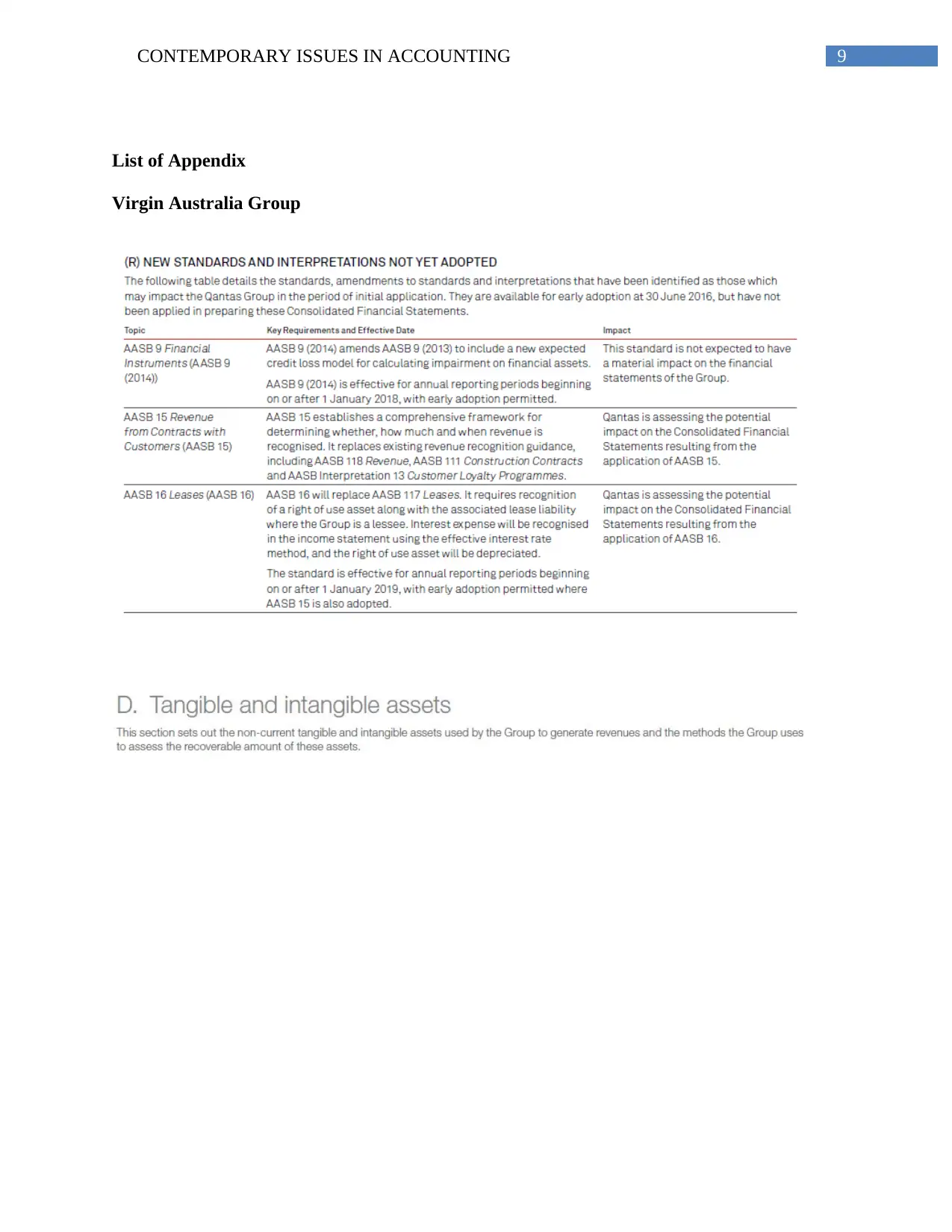
9CONTEMPORARY ISSUES IN ACCOUNTING
List of Appendix
Virgin Australia Group
List of Appendix
Virgin Australia Group
Paraphrase This Document
Need a fresh take? Get an instant paraphrase of this document with our AI Paraphraser
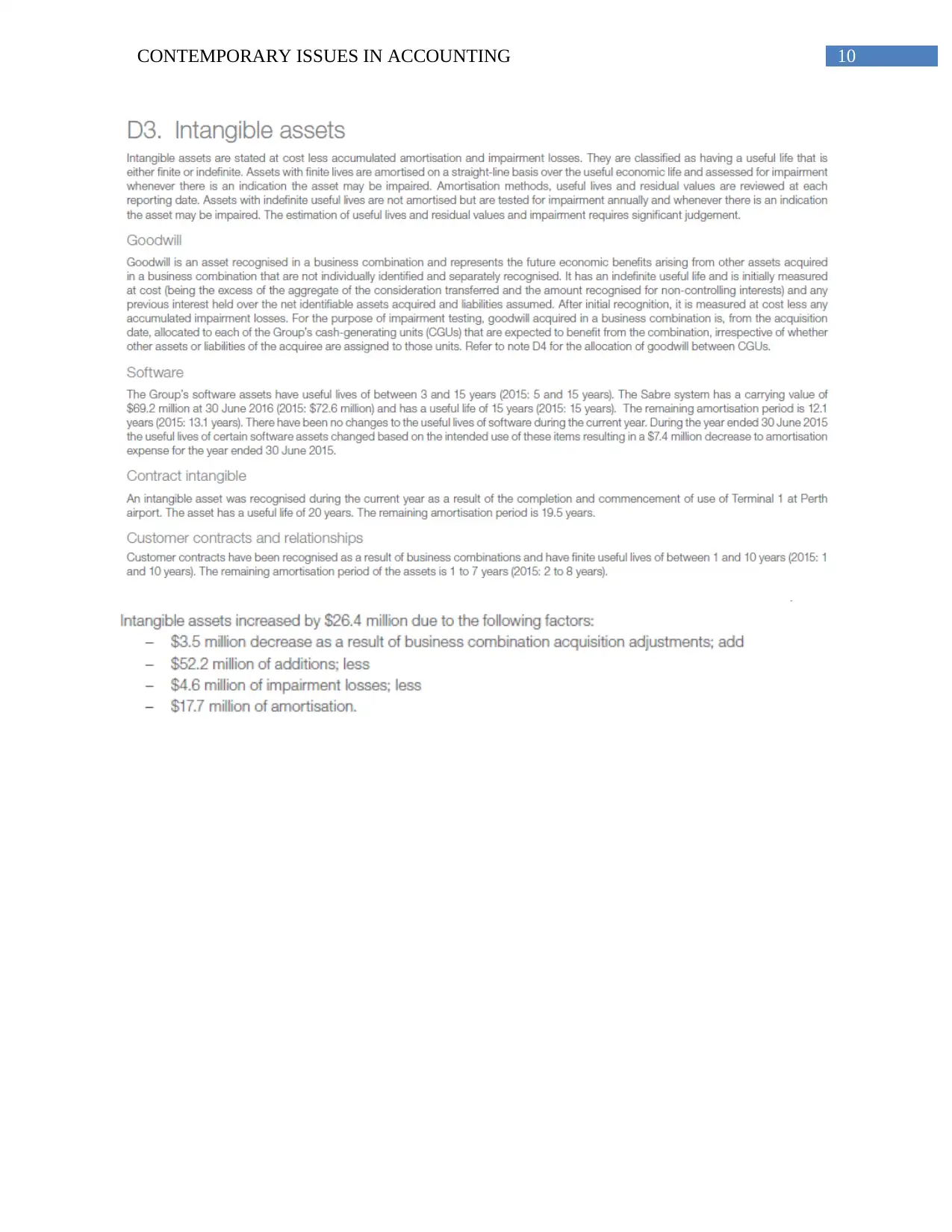
10CONTEMPORARY ISSUES IN ACCOUNTING
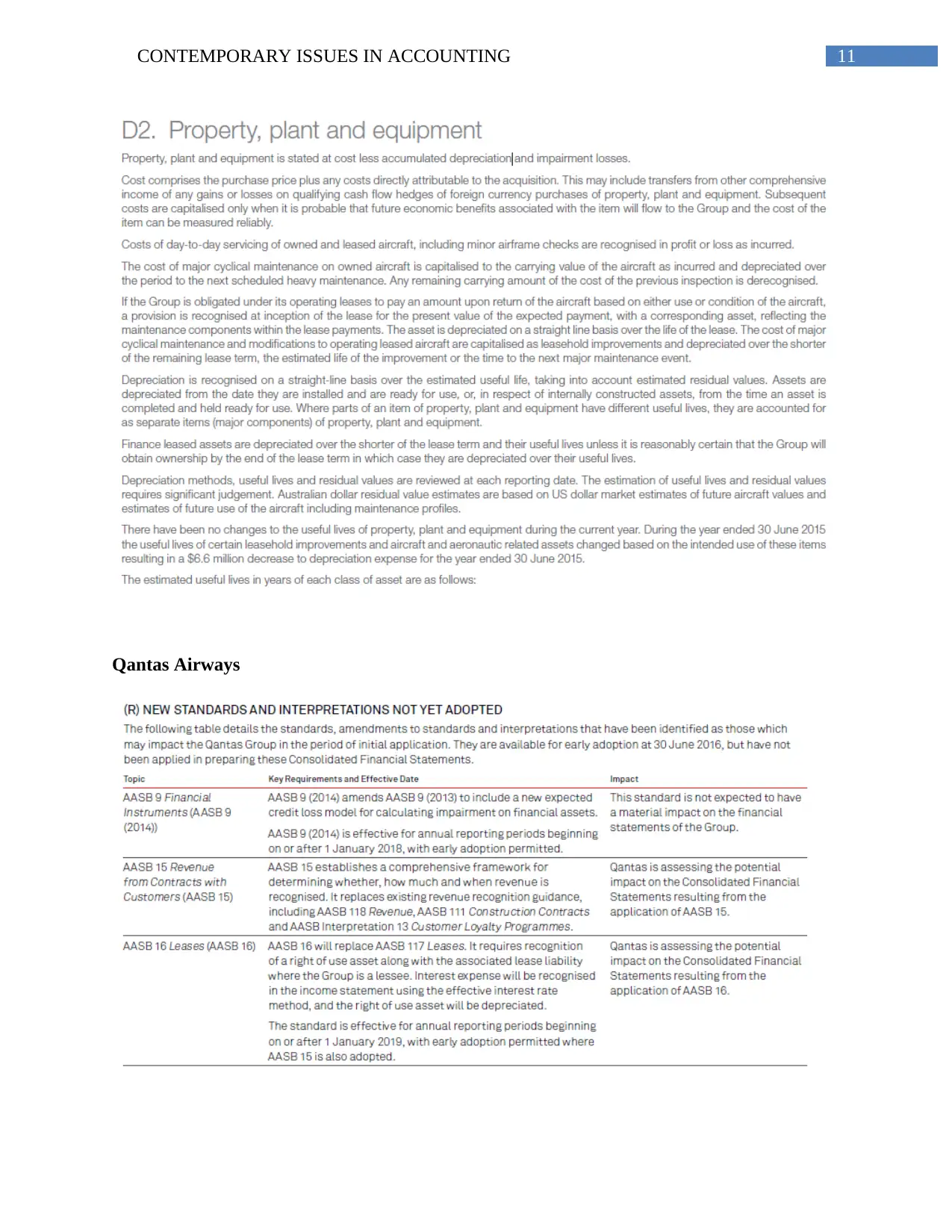
11CONTEMPORARY ISSUES IN ACCOUNTING
Qantas Airways
Qantas Airways
⊘ This is a preview!⊘
Do you want full access?
Subscribe today to unlock all pages.

Trusted by 1+ million students worldwide
1 out of 17
Related Documents
Your All-in-One AI-Powered Toolkit for Academic Success.
+13062052269
info@desklib.com
Available 24*7 on WhatsApp / Email
![[object Object]](/_next/static/media/star-bottom.7253800d.svg)
Unlock your academic potential
Copyright © 2020–2025 A2Z Services. All Rights Reserved. Developed and managed by ZUCOL.




